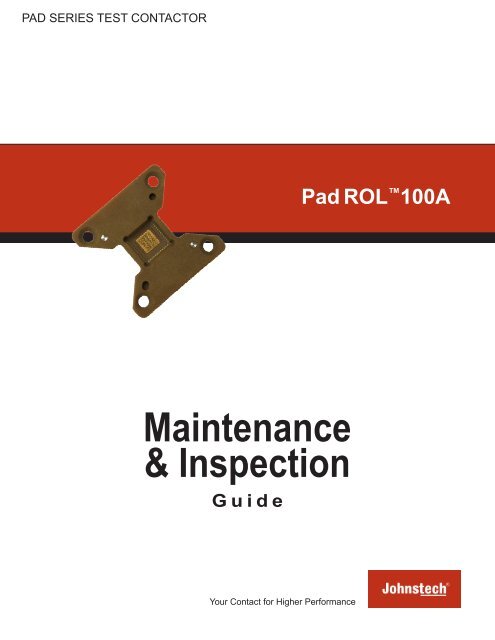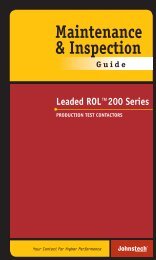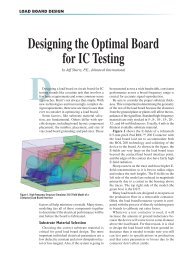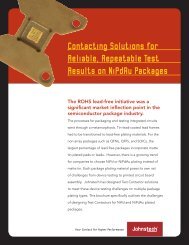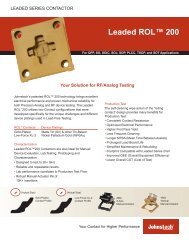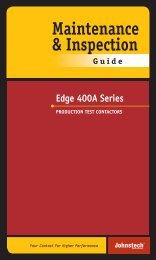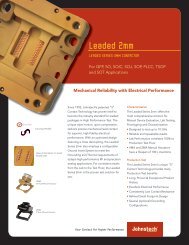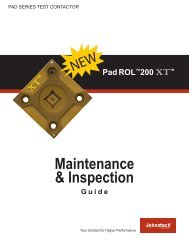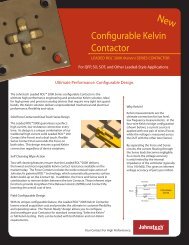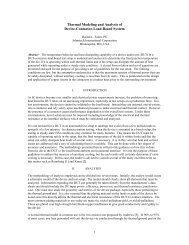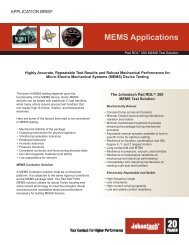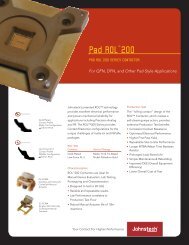Maintenance & Inspection Guide - Johnstech
Maintenance & Inspection Guide - Johnstech
Maintenance & Inspection Guide - Johnstech
Create successful ePaper yourself
Turn your PDF publications into a flip-book with our unique Google optimized e-Paper software.
PAD SERIES TEST CONTACTORPad ROL 100A<strong>Maintenance</strong>& <strong>Inspection</strong><strong>Guide</strong>Your Contact for Higher Performance
Pad ROL 100AFor questions about anythingcontained in this <strong>Maintenance</strong> &<strong>Inspection</strong> <strong>Guide</strong>, contact yourlocal <strong>Johnstech</strong> representative.If you are experiencing a technicalproblem or issue, fill out the onlineTech Help Form at:www.johnstech.com(All forms will be responded towithin two business days.)OR contact the nearest FieldService Office.(Turn to the back cover foraddresses/phone numbers.)ABOUT JOHNSTECHSince 1992, <strong>Johnstech</strong> International Corporation, headquartered in Minneapolis,MN, has been a leading provider of interconnect solutions for semiconductormanufacturers who want higher first-pass yields and lower overall cost of test.<strong>Johnstech</strong>’s high performance Test Contactors are available in Pad, Leaded,BGA, and Edge packages and are based on patented technology that providessuperior electrical and mechanical performance. <strong>Johnstech</strong> also partnerswith Handler, Tester and Load Board manufacturers to ensure appropriateinterfaces. With offices in the United States and Singapore; Field Service officesin California, Singapore, Philippines; and representation in China, Israel, Japan,Korea, Southeast Asia (Malaysia, Philippines, Singapore, Thailand) and Taiwan,<strong>Johnstech</strong> is proud to provide worldwide service and support.(Please refer to the back cover for addresses and phone numbers or go toour website at www.johnstech.com.)TABLE OF CONTENTSStandard Product Information . . . . . . . . . . . . . . . . . . . . . . . . . . . . . . . . . . . . . . 3Contactor Component Information . . . . . . . . . . . . . . . . . . . . . . . . . . . . . . . . . . 4Contactor Identification Information . . . . . . . . . . . . . . . . . . . . . . . . . . . . . . . . . 5Contactor Configuration Verification . . . . . . . . . . . . . . . . . . . . . . . . . . . . . . . . 6Recommended Tools .......................... . . . . . . . . . . . . . . . . . . .7Cleaning and <strong>Maintenance</strong> Frequency . . . . . . . . . . . . . . . . . . . . . . . . . . . . . . . 8Pre-<strong>Maintenance</strong> Troubleshooting. . . . . . . . . . . . . . . . . . . . . . . . . . . . . . . . 9-10Load Board & Contactor <strong>Inspection</strong> . . . . . . . . . . . . . . . . . . . . . . . . . . . . . . . . 11Load Board <strong>Inspection</strong>. . . . . . . . . . . . . . . . . . . . . . . . . . . . . . . . . . . . . . . . . . . . 11Contactor <strong>Inspection</strong> ........................... . . . . . . . . . . . . . . . . . .11Housing, Elastomer & Contact <strong>Inspection</strong> . . . . . . . . . . . . . . . . . . . . . . . . . . . 12Housing <strong>Inspection</strong> ............................ . . . . . . . . . . . . . . . . . .12Elastomer <strong>Inspection</strong>. . . . . . . . . . . . . . . . . . . . . . . . . . . . . . . . . . . . . . . . . . . . . 12Contact <strong>Inspection</strong> ............................. . . . . . . . . . . . . . . . . . .12Oxide Buildup ................................ . . . . . . . . . . . . . . . . . .12Contactor Removal & Installation . . . . . . . . . . . . . . . . . . . . . . . . . . . . . . . . . . 13Contact & Elastomer Removal . . . . . . . . . . . . . . . . . . . . . . . . . . . . . . . . . . . . . 14Contactor Cleaning . . . . . . . . . . . . . . . . . . . . . . . . . . . . . . . . . . . . . . . . . . . 15-17Light Cleaning ................................ . . . . . . . . . . . . . . . . . .15Thorough/Ultrasonic Cleaning . . . . . . . . . . . . . . . . . . . . . . . . . . . . . . . . . . . . . . 16Elastomer Installation . . . . . . . . . . . . . . . . . . . . . . . . . . . . . . . . . . . . . . . . . . . . 18Contact Installation . . . . . . . . . . . . . . . . . . . . . . . . . . . . . . . . . . . . . . . . . . . . . . 19Installation Verification ......................... . . . . . . . . . . . . . . . . . .20Grounding Information ......................... . . . . . . . . . . . . . . . 21-24Grounding Solutions Information. . . . . . . . . . . . . . . . . . . . . . . . . . . . . . . . . . . . 21Ground Insert Removal ......................... . . . . . . . . . . . . . . . . . .22Ground Insert Installation (New RCI). . . . . . . . . . . . . . . . . . . . . . . . . . . . . . . . . 23Ground Insert Installation (Snap Fit RCI) . . . . . . . . . . . . . . . . . . . . . . . . . . . . . 242www.johnstech.com©2012 <strong>Johnstech</strong> International CorporationAll rights reserved.
Pad ROL 100ASTANDARD PRODUCT INFORMATIONElectrical Specifications Matte Tin Configuration NiPdAu ConfigurationElectrical Length(compressed height):1.10 mm 1.14 mmInductance: Self: 0.23 nH Self: 0.37 nHMutual: 0.14 nHMutual: 0.15 nHCapacitance: Ground: 0.16 pF Ground: 0.17 pFMutual: 0.05 pFMutual: 0.05 pFS 21Insertion Loss (GSG): -1dB @ 40 GHz -1dB @ 40 GHzS 11Return Loss (GSG): -20dB @ 14.5 GHz -20dB @ 18.3 GHzS 41Crosstalk (GSSG): -20dB @ 32 GHz -20dB @ 33.5 GHzAverage CRES: 50 mOhms 25 mOhmsCurrent Carrying Capability: 4 A 2.6 ACurrent Leakage:
Pad ROL 100ANote: The Green/RedElastomer and Gold-PlatedContact (153164) for mattetin packages are shown in theillustrations throughout thisdocument. For the NiPdAupackage configuration, refer topage 4 for the correct Contactand Elastomer configuration.Standard PartsMost <strong>Johnstech</strong> Contactorshave four standard partsthat comprise the Contactorassembly:· Housing· Contacts· Elastomers· Alignment Plate*A Manual Actuator is availablefor short-run testing andcharacterization.CONTACTOR COMPONENTSMethodologyDevice Under TestContactInner/Front ElastomerOuter/Back ElastomerLoad Board*An Alignment Plate is includedwith the Contactorfor all designs utilizing anAlignment Plate duringautomated test operation.All other designs include anAlignment Plate as part of theManual Actuator assembly.Leadbackers and AlignmentPlates work as matchedsets; changing either onemay require changing bothcomponents.**A Single-Latch VerticallyCompliant Manual Actuator(SL-VCMA), pictured here, isalso offered for select PadROL 100A Housing sizes.Contactor ComponentsDouble-Latch Vertically Compliant Manual Actuator(DL-VCMA Plus)**Alignment PlateHousingFully-Assembled Contactor4www.johnstech.com©2012 <strong>Johnstech</strong> International CorporationAll rights reserved.
Pad ROL 100ACONTACTOR INDENTIFICATIONSample Contactor, Load Board Side Up8. Device Body 1. Manufacturer 5. Assembly 6. Device 7. DeviceSize (mm) Type Count Type4. Design Number9. Pitch (mm)3. ManufacturingDate Code10. Part Number2. Serial NumberIdentificationEach <strong>Johnstech</strong> contactor will have as much information as space allows. Theidentification system is designed to provide you with the technical informationyou need to identify the contactor and its Design Data Sheet (example shown onthe facing page).Here is how to read the different data fields on the Contactors:1. JTI- identifies <strong>Johnstech</strong> International as the manufacturer2. Serial Number3. Manufacturing Date Code (see tables at right)4. Design NumberFor Custom Orders:1234-YYZZ, YY = Contactor Technology Code (i.e. 01 = ROL100; 02 =ROL200) ZZ = Configuration (or design iteration) NumberFor SelecTest Orders:6XXX-8XXXXX, 6XXX = Design Number 8XXXXX = Configuration Number5. Assembly TypeTS: Test SocketMA: Manual ActuatorSL: Single-Latch MADL: Double-Latch MA6. Perimeter Pad Count7. Package Type8. Body Size (mm)9. Pad Pitch (mm)10. Part Number (will appear only if Contactor is a SelecTest® order)Date Code ReferenceWeekYearLetter Number Letter NumberA 1 A 1991B 2 B 1992C 3 C 1993D 4 D 1994E 5 E 1995F 6 F 1996G 7 G 1997H 8 H 1998I 9 I 1999J 10 J 2000K 11 K 2001L 12 L 2002M 13 M 2003N 14 N 2004O 15 O 2005P 16 P 2006Q 17 Q 2007R 18 R 2008S 19 S 2009T 20 T 2010U 21 U 2011V 22 V 2012W 23 W 2013X 24 X 2014Y 25 Y 2015Z 26 Z 2016AA 27AB 28AC 29AD 30AE 31AF 32AG 33AH 34AI 35AJ 36AK 37AL 38AM 39AN 40AO 41AP 42AQ 43AR 44AS 45AT 46AU 47AV 48AW 49AX 50AY 51AZ 52Data CodeExamples:SN123456BVB = Week 2V = 2012SN654321AATAA = Week 27T = 2010www.johnstech.com©2012 <strong>Johnstech</strong> International CorporationAll rights reserved.5
Pad ROL 100ARECOMMENDED TOOLSFor installing and maintaining <strong>Johnstech</strong> Contactors:• Screwdriver with Allen-Head Bits for fastening the contactor to the load board.• 10X Eye Loupe for magnified inspection of contactor, elastomers and contacts.• Elastomer Tool for use in elastomer installation as well as prying alignment plate from contactor.• Fine-Tip Non-Metallic Tweezers for handling contacts and elastomers.• Scalpel for marking elastomer lengths.• Micro Scissors for cutting elastomers to length.• Probe Tool for use in elastomer Installation.• Fiberglass Brush and Replacement Tips recommended for cleaning the contacts (Iffiberglass brushes are not allowed on the test floor, although not optimum, nylon brushes can besubstituted.)Extras:• Finger Cots recommended to prevent contaminating contactor components with skin oils.• Protective Eye wear recommended to protect technicians from test floor/contactor components,compressed air and other chemicals.CAUTION: Avoid touching the device and load board interface surfaces of thecontacts with metal tools. Scratches on these areas may degrade performance.Recommended Tools (in orderat right)<strong>Johnstech</strong>’s <strong>Maintenance</strong> & <strong>Inspection</strong> Kit<strong>Johnstech</strong>’s <strong>Maintenance</strong> & <strong>Inspection</strong> Kit contains many of the tools neededfor maintenance and inspection and are designed especially for <strong>Johnstech</strong> HighPerformance Contactors. Contact your <strong>Johnstech</strong> Representative for moreinformation.<strong>Maintenance</strong> Kit Part Numbers:• with torque screwdriver: 706449• without torque screwdriver: 706448www.johnstech.com©2012 <strong>Johnstech</strong> International CorporationAll rights reserved.7
Pad ROL 100ACLEANING & MAINTENANCE FREQUENCYDetermining FrequencyDue to a wide range of variables (like those listed below), each test floor mustdetermine their optimal cleaning and maintenance intervals through effectiveuse of statistical process control. By carefully monitoring and recording yieldrates and following good test floor troubleshooting procedures, you will be ableto clearly differentiate between interface vs. maintenance problems and aneffective maintenance cleaning cycle can be established to match the needs ofeach test floor. Contact your <strong>Johnstech</strong> Representative or Field Service for furtherinformation or help.Handler Design and SetupHandlers have a variety of test plane configurations, device transportationmethods, plunge mechanisms and accessories. Each handler has its own uniqueattributes. Handler set-ups that are not optimized can increase the requiredmaintenance frequency by contributing to premature contactor and elastomer wearand oxide build-up on the contacts. By working with <strong>Johnstech</strong> and your handlersupplier, you can optimize handler/contactor performance to minimize downtime.Correct Contact Compressed HeightIncorrect contact compressed height reduces the effectiveness of the contact’s selfcleaningwipe and may cause increased oxide build-up and/or decreased contact lifeand load board pad life. It may also adversely affect elastomer life by creating tears,cuts or compression set (permanent deformation) shown on Page 12. The contactcompressed height for each contactor is specified on the design data sheet.Package and Device Plating VariationsVariations in packages can affect your maintenance schedule. Different packagevendors, or even different device lots, may have varying amounts of mold flash thatcan decrease wear on the contactor and alter device placement. Also, the methodused for plating the device can vary the rate of debris build-up, and thereforevarying the maintenance interval.ContaminantsAccumulation of contaminants on the contactor and/or load board (such as oxidesand mold flash) will contribute to continuity and/or parametric failures during thetest process.General Test Floor <strong>Maintenance</strong> ActivitiesThe frequency of handler maintenance procedures also affects contactor cleaning.For example, how often the handler and handler test areas are blown free and/or vacuumed of debris impacts the effectiveness of the contactor. Contactorsexposed to increased levels of foreign debris are likely to require more frequentmaintenance and cleaning.8www.johnstech.com©2012 <strong>Johnstech</strong> International CorporationAll rights reserved.
Pad ROL 100APRE-MAINTENANCE TROUBLESHOOTINGThis Pre-<strong>Maintenance</strong> Troubleshooting section is to help you determine whichpart of your <strong>Johnstech</strong> contactor may be inspected and/or serviced to address aparticular test problem. This section doesn’t cover test floor, handler, device or anyother variables that may be contributing to your test problem. If you still experienceproblems after following the <strong>Maintenance</strong> Instructions herein, contact your local<strong>Johnstech</strong> Representative or complete the form at: www.johnstech.com/support.Experiencing Yield Fall-Off?There are many reasons you may be experiencing yield fall-off but it can frequentlybe attributed to either parametric or continuity failures.Parametric ailures are typically due to increased contact resistance whichcan be caused by:• Dirty Contacts: Inspect contacts per instructions on Page 12.• Worn or Damaged Elastomers: Inspect elastomers per instructions on Page 12.• Device-Pad-to-Contact Alignment: Inspect the contactor registration per instructions on Page11.• Worn or Damaged Alignment Plate: Inspect the alignment plate under contactor <strong>Inspection</strong>instructions on Page 11.• Worn or Damaged Leadbacker/Nest: Inspect the leadbacker and nest.• Oxidation/Contamination of the Load Board: Inspect the load board per instructions on Page11.• Excessive Load Board Pad Wear: Inspect the load board per instructions on Page 11.Continuity failures are typically due to open/short failures which can becaused by:• Excessive Loose Debris: Inspect contactor per instructions on Page 11.• Worn or Damaged Contacts: Inspect contacts per instructions on Page 12.• Worn or Damaged Elastomers: Inspect elastomers per instructions on Page 12.• Worn or Damaged Alignment Plate: Inspect the alignment plate opening under the contactorinspection instructions on Page 11.• Worn or Damaged Leadbacker/Nest: Inspect the leadbacker and nest.• Contamination of the Load Board: Inspect the load board per instructions on Page 11.If experiencing problems inautomated test, first answerthese 2 questions.1) Does the test socket workwhen manually testing with theManual Actuator?2) Do the witness marks fromthe Manual Actuator test lookthe same as those from theautomated test?If the answer to both questionsis YES, then your test problemis probably caused by somevariable other than your<strong>Johnstech</strong> Contactor.If the answer to either questionis NO, then read through thechecklists on these 2 pages,under the problem (in red) thatyou are experiencing.If this application has run wellpreviously but is now failing,the troubleshooting mustdetermine what has changed.If this is a new applicationtroubleshooting must examinethe original design.www.johnstech.com©2012 <strong>Johnstech</strong> International CorporationAll rights reserved.9
Pad ROL 100APRE-MAINTENANCE TROUBLESHOOTINGExperiencing Device Damage or Jamming?There can be many reasons why you may experience device damage or Jamming.For example, incorrectly designed or incompatible, worn or damaged handler/contactor components may cause pad damage or device jamming.Device pad damage or improper wipe can happen when contacts are out ofalignment. Witness marks will be off-center of device pads, which can occurdue to:• Worn or Damaged Alignment Plate Opening Inspect the alignment plate under contactor<strong>Inspection</strong> instructions on Page 11.• Worn or Damaged Leadbacker/Nest Inspect the leadbacker and nest.• Changes in Package Singulation Verify that the alignment plate and leadbacker are correct forthe device by comparing device dimensions to the design data sheet.• Improper Overtravel Control Verify that leadbacker/Nest has proper overtravel control. Referto the Contactor Specifications on your Design Data Sheet for compressed, uncompressed andovertravel stop dimensions.• Worn or Damaged Housing Slots Inspect housing per instructions on Page 12.Device pad damage or improper wipe can also occur when devicesexperience over deflection, whereby large witness marks appear. This is canbe attributed to:• Worn or Damaged Contacts Inspect contacts per instructions on Page 12.• Worn or Damaged Elastomers Inspect elastomers per instructions on Page 12.• Improper Elastomers or Elastomer Installation Verify that elastomers are correct per the designdata sheet and make sure Installation was performed per instructionson Pages 17 & 19.• Worn or Damaged Leadbacker/Nest Inspect the leadbacker and nest.• Improper Overtravel Control Verify that leadbacker/nest has proper overtravel control. Referto the Contactor Specifications on your Design Data Sheet for compressed, uncompressed andovertravel Stop dimensions.• Worn or Damaged Housing Tail Stop Inspect the contactor per instructions on Pages 11 & 12.Device Jams can occur due to:• Device-Pad-to-Contact Alignment Inspect the contactor per instructions on Page 11.• Worn or Damaged Alignment Plate Opening Inspect the alignment plate opening undercontactor inspection instructions on Page 11.• Worn or Damaged Leadbacker/Nest Inspect the leadbacker and nest.• Changes in Package Singulation Verify that the alignment plate and leadbacker are correct forthe device by comparing device dimensions to the design data sheet.• Improper Overtravel Control Verify that leadbacker/nest has proper overtravel control. Referto the Contactor Specifications on your Design Data Sheet for compressed, uncompressed andovertravel stop dimensions.10www.johnstech.com©2012 <strong>Johnstech</strong> International CorporationAll rights reserved.
Pad ROL 100AHOUSING, ELASTOMER & CONTACT INSPECTIONHousing <strong>Inspection</strong>In order to inspect the housing, elastomers and contacts, the contactor must beremoved from the load board and disassembled. Refer to instructions on Pages13-14.Figure 5: Acceptable contactwipe on pad (Matte Tin).Pad ROL 100A Series Housings have a recommended lifespan of 1 millioninsertions. Take the dismounted/disassembled contactor and using a minimumof 10X magnification, inspect the Housing for signs tail stop wear. If the tail stopdepth exceeds 0.05mm (see Figure 4), replace the housing. Conversely, if thecontact wipe on the device pad is not placed correctly (see Figure 5), check thealignment plate walls and opening and tail stop wall for wear. If observed, replacethe alignment plate.Figure 6: Example of cutelastomer; needs to be replaced.Elastomer <strong>Inspection</strong>Using 10X+ magnification, inspect elastomers for signs of:• Cuts or tears• Compression set• Stretched sectionsUpon inspection, if you see excessively cut or torn elastomers (see Figure 6), or ifthe compression set exceeds 0.05mm (see Figure 7), replace elastomers to regainoptimum performance.Figure 7: Example ofcompression set; this elastomerneeds to be replaced.Figure 8: Example of oxidebuildup on contact tip (photo isfrom a test on Matte Tin).Contact <strong>Inspection</strong>Using 10X+ magnification, inspect contacts for signs of:• Worn Tips• Scratches or markings• Oxide buildup (see Figure 8)• Debris buildup• Compressed/distorted shapeIf any of the above are observed, discard used contacts and replace with newones.Oxide BuildupThe self-cleaning wipe-action of ROL Technology is designed to greatly reducethe amount of oxide buildup on contacts. However, some oxide buildup will occurif contactors are unused for 2 or more days, appearing dull gray in color (see Figure8). A light brushing or a few device insertions will typically remove the oxide barrierand expose a shiny surface. Clean the contactor after prolonged downtime or ifyou experience a decrease in yields. Refer to Cleaning Procedures on Pages 15-16.NOTE: If contacts have significant/excessive oxide buildup, check all componentsin test cell to ensure that device alignment and plunge depth are correct.12www.johnstech.com©2012 <strong>Johnstech</strong> International CorporationAll rights reserved.
Pad ROL 100ACONTRACTOR REMOVAL AND INSTALLATIONContactor Removal & Installation InstructionsIt is recommended that you remove your Pad ROL 100A Series Contactor fromthe load board before performing any component inspection, cleaning and/ormaintenance.Step 1: Remove Contactor• Start removal of the contactor from the load board by loosening the fasteners. While carefully liftingcontactor from load board, use a microscope to see if contacts or ground Insert are sticking to themounting surface.• If either is sticking, apply several drops of Isopropyl Alcohol through contact slots and allow it tosoak for two minutes before lifting from load board.• Remove the fasteners and once contactor is removed, inspect it for any loose ormissing contacts.• Mount the contactor to the acrylic mounting plate for storage.Step 2: Perform <strong>Maintenance</strong> & Cleaning• Perform the maintenance and cleaning per the instructions contained on the following pages.Step 3: Clean Load Board• Before remounting the contactor to the load board, ensure that no debris is present in theinterface areas.• If necessary, use compressed air and/or Isopropyl Alcohol with a clean lint-free cloth to carefullywipe the bottom of the contactor and the surface of the load board clean.NOTE: NEVER use Acetone or other solvents.Figure 9: Screw tighteningpattern.RecommendedTorque Valuesin.-lb. Nm0-80 1.0 0.112-56 2.0 0.234-40 5.0 0.56M1.4 x 0.3 0.4 0.04M1.6 x 0.35 0.6 0.06M2 x 0.40 1.3 0.15M2.5 x 0.45 2.5 0.28M3 x 0.5 4.5 0.51M4 x 0.7 8.0 0.90Step 4: Install Contactor• Refer to the load board drawing that was sent with either your quote or order for proper footprintlayout.• Fasten the contactor to the load board by fitting the screws through the contactor and engagingseveral threads.• Under a microscope or 10X Eye Loupe, inspect the contact tips for alignment. Misalignedcontacts can damage the alignment plate, housing and load board.• Use the elastomer tool to realign contacts where necessary.• Evenly tighten the fasteners in a crisscross pattern (see Figure 9).• To avoid damage to the contactor or threaded inserts in the load board, the contactor mountingscrews should be tightened, according to the Recommended Torque Values in the table at left.Step 5: Verify Contacts• Verify that all contacts are properly positioned.• Gently actuate all of the contacts with an elastomer tool to ensure proper contact motion.Step 6: Verify Test Set-up• Verify the Device-to-Contactor alignment and handler plunge depth, as well as the X-Ypresentation.www.johnstech.com©2012 <strong>Johnstech</strong> International CorporationAll rights reserved.13
Pad ROL 100ACONTACT & ELASTOMER REMOVALContact & Elastomer Removal InstructionsCAUTION: Avoid putting pressure on slot walls and webs by not resting hands ortools in these areas while working on the contactor (see Figures 10 & 11).Figure 10: Slot walls.Figure 11: Slot webs.Step 1: Remove Inner/Front Elastomer• Turn contactor over so load board side faces up.• Use a tweezers to pull out the inner/front (green) elastomer from the contactor (see Figure 12).• Inspect elastomer to determine whether they can be reused or will need to be discarded.Step 2: Remove Contacts• With contactor still load board side up, use a tweezers to carefully pull contact out of housing (seeFigure 13).• Many people find it easiest to start at one corner and work your way around the contactor, butremoval order is unimportant.• Inspect contacts to determine if they need to be discarded or can be reused.• If your intent is to just change out the elastomers and reuse the contacts, take extra care in theremoval process.• Do not squeeze or bend them and do not touch the tips, which can affect performance.• Either discard worn contacts or set aside for reassembly.Step 3: Remove Outer/Back Elastomer• As in Step 1 above, use a tweezers to pull out the outer/back (red) elastomer (see Figure 14).• Inspect for signs of wear per instructions on Page 12 and either set aside for reinstallation ordiscard.NOTE: It is recommended to just discard used elastomers and assemble contactorwith new ones, but if they are in exceptionally good shape, they can be set asideand reinstalled. Blow with compressed air before reinstalling.Figure 12: Removal of inner/front (green) elastomer.Figure 13: Contact removal.Figure 14: Removal of outer/back (red) elastomer.14www.johnstech.com©2012 <strong>Johnstech</strong> International CorporationAll rights reserved.
Pad ROL 100ACONTACTOR CLEANINGIf debris buildup is observable upon inspection of the contactor or you experience adrop in yields or an increase in resistance, follow the Light Cleaning Procedure onthis page.Note: A fiberglass brush is always recommend best for contactor cleaning but ifyou don’t have or are not allowed to use a fiberglass brush, a nylon brush may beused as a substitute.Figure 15: Separating housingand alignment plate.Light Cleaning ProcedureStep 1: Remove Contactor from Load Board• Refer to instructions on Page 13, Step 1.Step 2: Remove Alignment Plate• Use a scalpel to gently pry apart the housing and alignment plate, working in an even andincremental manner around the housing to avoid binding (see Figure 15).Step 3: Brush the Top Side of Contactor• Mount contactor to the acrylic mounting plate.• Use a fiberglass (or nylon) brush to gently clean both the perimeter and ground (even if in aground insert) contact tips, brushing from the outside in, toward the center of the contactor (seeFigure 16).Figure 16: Correct direction forcontact brushing on the top sideof the contactor.Step 4: Brush the Bottom Side of Contactor• Remove contactor from the acrylic mounting plate and turn over so the load board side is up.• Use the fiberglass (or nylon) brush again to gently clean both the perimeter and ground (even if ina ground insert) contact bottoms.• This time brush from the center of the contactor outward (see Figure 17).• Avoid brushing elastomers.Step 5: Clear DebrisRemove any loose debris from the Contactor using one or both of these methods:• Dry, clean Compressed Air (20psi or less) (see Figure 18).• A small vacuum.Figure 17: Correct direction forcontact brushing on the bottomside of the contactor.Be sure to thoroughly clear debris from every part of the contactor, including theelastomer and contact slots. If no loose debris remains, the contactor may bereassembled and reinstalled.NOTE: If remaining debris or foreign matter is observed, even after performing thisLight Cleaning Procedure, try the Thorough Cleaning Procedure on the next page.Step 6: Clean Handler• Clean the handler per the manufacturer’s recommendations.Step 7: Reinstall Contactor• If no loose debris remains on the contactor, remount it to the load board per the instructions onPage 13, Step 4.Figure 18: Compressed aircleaning.www.johnstech.com©2012 <strong>Johnstech</strong> International CorporationAll rights reserved.15
Pad ROL 100ACONTACTOR CLEANINGThorough Cleaning ProcedureIf the contactor and alignment plate have excessive debris buildup, it is stronglyrecommended to perform a thorough cleaning with an ultrasonic cleaner. Onlyexecute this procedure in a well ventilated area with an exhaust hood.Figure 20: Example of cleaning ahousing in an ultrasonic cleaner;note left position.Figure 21: Example of rinsing ahousing in an ultrasonic cleaner;note right position.CAUTION: The ultrasonic cleaner should have a maximum power of 500W and acatch basket in the tank that prevents the contactor from touching settled debris.Step 1: Prepare the Housing• Remove the contactor from the load board per instructions on Page 13, Step 1.• Gently pry apart the housing and alignment plate per instructions in Step 2 on the opposite page.• Remove ground insert if contactor has one. Refer to ground insert remove instructions on Page22.• If contacts and elastomers require replacement for either the housing or ground Insert, removedthe used contacts and elastomers.• If the contacts and elastomers are in good condition they can be left in the housing during thefollowing cleaning procedures.Step 2: Prepare the Bath• Prepare a bath of diluted Isopropyl Alcohol (70/30 Alcohol/Water) OR a heated (40-50ºC max)mild acidic (7.1 > ph > 3.0) solution.NOTE: If a sonic cleaner is unavailable, gently brush the housing with bathsolution (see above), rinse in deionized water and dry housing out completely.Step 3: Perform the Cleaning (Operate Ultrasonic Cleaner per Manufacturer’sInstructions only).• Fully immerse the populated or unpopulated housing device-side down. The bath should be preheatedand run for a minimum of a 30 minute cycle (see Figure 22).• Also, place the alignment plate and the ground insert into the bath.• Remove housing, alignment plate and ground insert from the bath and sonic rinse and rinse withdeionized water for about 10 minutes (see Figure 23).NOTE: For populated contactor housings or populated ground inserts, inspectfor missing contacts before moving then to the rinse bath. Some contacts maydislodge during the ultrasonic cleaning. Collect them and move them to the rinsebath and then reinstall before drying.16www.johnstech.com©2012 <strong>Johnstech</strong> International CorporationAll rights reserved.
Pad ROL 100ACONTACTOR CLEANINGStep 4: Dry the ContactorCurrent leakage may occur during testing if moisture remains on the Contacts. Toprevent this:• Carefully pat the contactor dry with a lint-free cloth.• Blow the contactor dry with heated air (see Figure 22).• If necessary, place in oven for approx. 10 minutes.CAUTION: DO NOT use heat guns to blow contactors dry. Heated air should notexceed 100ºC or be utilized for longer than 30 minutes.Figure 22: Heated air drying, acommon hair dryer will suffice.Step 5: Reassemble the Contactor• Reassemble the contactor per instructions on Pages 17-18.Step 6: Reinstall Contactor• Inspect contactor one final time for any debris, damage or moisture.• Remount contactor to load board per instructions on Page 13, Step 4.www.johnstech.com©2012 <strong>Johnstech</strong> International CorporationAll rights reserved.17
Pad ROL 100AELASTOMER INSTALLATIONElastomer Installation InstructionsBefore beginning, use low-pressue, clean compressed air on contactor to blowaway any debris.Figure 22: Mark elastomer atappropriate length.Step 1: Cut Red Outer/Back Elastomers to Length• Turn contactor load board side up.• Lay a length of the (red) elastomer next to the outer/back elastomer slot.• Use a blade to mark the elastomer (see Figure 22) at the correct length, which is halfway intoeach end well (see Figure 23). Use care not to cut the Torlon® Housing.• Use a micro-scissors to cut elastomer straight across.• Cut the remaining three elastomers (for a total of four red) to this same length.• Store unused elastomer in original packaging only.Step 2: Install Red Outer/Back ElastomersNOTE: Lubricate elastomers with Isopropyl Alcohol, if needed, to facilitateinstallation. Please use special care to avoid bunching, stretching or twisting theelastomer. Proper elastomer installation helps optimize performance.Figure 23: Proper fit of redelastomer in end wells.Figure 24: Use elastomer tool topush elastomer into outer slot.• With contactor still load board side up, center the red elastomer over one of the outer/backelastomer slots.• Using an elastomer tool, gently push down into place (see Figure 24).Repeat outer/back elastomer installation for the remaining three sides.Step 3: Install Green Inner/Front Elastomers• Cut one end of the green elastomer straight across.• Insert the cut end into the end well of the inner/front elastomer slot (see Figure 23).• Using a tweezers, gently “pinch and tuck” elastomer into the elastomer slot (see Figure 25).Continue working towards the right “pinching and tucking” at each consecutive rib in sequence(see Figure 26) until the right end of the elastomer is securely positioned just outside the end well.• Cut the end of elastomer straight across (see Figure 23).• Install the remaining inner elastomers in the same manner. The elastomers should touch at thecorners (see Figure 23). Please note that the green elastomers will fit more snugly into the inner/front elastomer slots than the red elastomers did for the outer/back elastomer slots.NOTE: Use a delicate touch when squeezing elastomer to avoid nicks and cuts.DO NOT bunch or stretch the elastomers.NOTE: See Page 23 for ground insert elastomer installation instructions.Figure 25: Gently “pinch andtuck” green elastomer into innerelastomer slot.Figure 26: “Pinch and tuck” greenelastomer from one end to theother.18www.johnstech.com©2012 <strong>Johnstech</strong> International CorporationAll rights reserved.
Pad ROL 100ACONTACT INSTALLATIONContact Installation InstructionsCAUTION: Avoid putting pressure on slot walls and webs by not resting hands ortools in these areas while working on the contactor (see Figures 11 & 12 on Page14).Step 1: Align and Insert Contact• Turn contactor load board side up.• Using a tweezers, dip contact in Isopropyl Alcohol. (The alcohol lubricates the contact, makinginsertion easier.)• Start installation at the far left contact slot on any side. Align the contact above the contact slot(see Figure 28) and press the contact down between the gap in the elastomers (see Figure 29).Figure 27: Align above andbetween elastomers.Step 2: Position Contact and Insert Further• Manuever the head of the contact down and towards the center of the contactor (see Figure 30).Step 3: Final Adjustment• Use tweezers to gently rotate the contact tail down onto the outer (purple) elastomer until the fit issnug (see Figure 31).Step 4: Installation Pattern• Continue installing contacts in the repeating left-right-center sequence shown below, per the stepsabove, until entire side is populated. Proceed on to each side in the same manner.Figure 28: Insert downward intogap between elastomers.1 4 6 3 5 2Contact Insertion OrderFigure 29: Gently push contacthead towards center of contactor.NOTE: It is recommended to mount the contactor onto the acrylic mounting plateas shown on Page 4 when not in use or for inspecting, storing or shipping. If thecontactor is stored on acrylic mounting plate for over a week, loosen screws to avoidcompression set on the rear elastomer.Figure 30: Gently push contacttail down onto red elastomer.www.johnstech.com©2012 <strong>Johnstech</strong> International CorporationAll rights reserved.19
Pad ROL 100AINSTALLATION VERIFICATIONIt is extremely important for the elastomer to be installed correctly in order to getoptimum performance from your Pad ROL 100A Series Contactor.Double-check your elastomer installation by taking the acrylic mounting plate andgently pressing it down, evenly, onto the load board side of your Pad ROL 100AContactor. A correctly installed contactor should look like this picture below.Correct/proper installation of elastomers.Clear/red elastomers for NiPdAu packageconfiguration shown.Incorrect Installation of elastomers. Redelastomers are traveling too far into theend wells. Please remove and reinstallper instructions on Page 18 for optimumperformance. Green/red elastomers formatte tin package configuration shown.Green elastomers have too much gapat the corner. See above picture forcomparison.20www.johnstech.com©2012 <strong>Johnstech</strong> International CorporationAll rights reserved.
Pad ROL 100AGROUNDING SOLUTIONSThe Pad ROL 100A Series offers three main Grounding Options:RCI: ROL Contacts in a Copper Insert, for 4x4-12x12 packages• New elastomer retention design (see Figure 31).• Original Flex-Fit design (see Figure 32).CI: Copper Insert for 3x3 packagesRTH: ROL Contacts in Torlon Housing, (see Figure 33)Figure 31: RCI ground insert(New Elastomer retentiondesign).In order to maintain proper operation and ensure a long life for your groundingsolution, you will need to perform cleaning and maintenance, much like you need todo for the other components of your Pad ROL 100A Series Contactor.Ground InsertsRCI and CI ground inserts need to be removed for cleaning and maintenance perthe instructions on Page 22. Then follow the Cleaning & Installation instructions onPage 22.Ground Contact <strong>Maintenance</strong><strong>Inspection</strong>, cleaning and change-out of the ground contacts & elastomers can beperformed in the same manner as the perimeter contacts and elastomers. However,please note that depending on which way the ground contacts are oriented, thedirection of brushing when performing the Light Cleaning Procedure will vary. Referto Figures 15 & 18 on Page 15.Figure 32: RCI ground insert(Original Flex-Fit design).Figure 33: RTH grounding.www.johnstech.com©2012 <strong>Johnstech</strong> International CorporationAll rights reserved.21
Pad ROL 100A→Figure 36: A light downwardpush will free ground insert fromhousing.GROUND INSERT MAINTENANCEGround Insert Removal InstructionsIMPORTANT: Use finger cots when handling ground inserts to avoid contaminationwith skin oils, which can degrade performance.Using covered fingers and/or the elastomer tool, press down on the ground insert.The insert will easily release out of the housing (see Figure 36).Ground Insert Cleaning InstructionsStep 1: Remove Contacts & Elastomers• Once the ground insert is removed from the housing, follow instructions for contact and elastomerremoval on Page 14.Step 2: Clean Ground Insert• Clean the unpopulated ground insert with a fiberglass (or nylon) brush per the instructions on Page15.• Follow up with ultrasonic cleaning, per instructions on Page 16.• Inspect for mushrooming or bending. If observed, contact <strong>Johnstech</strong> Field Service or yourRepresentative.Step 3: Re-assemble Ground Insert• Follow the instructions for Elastomer & Contact installation on Pages 18 & 19.Step 4: Blow with Compressed Air• To clear away any remaining debris, blow the Insert with compressed air before reinstalling groundinsert.• Inspect for remaining debris. If observed, repeat cleaning process again refer to Pages 15-16.22www.johnstech.com©2012 <strong>Johnstech</strong> International CorporationAll rights reserved.
Pad ROL 100AGROUND INSERT INSTALLATIONNew Elastomer Retention Ground Insert DesignIMPORTANT: Always ensure ground Insert is clean before installing and inspectused inserts for damage or wear.ElastomerretentiongroovesLedgesStep 1: Locate and Position the Ground Insert• Under magnification locate your ground insert and flip the insert right side up and lay on a flatsurface.Figure 35: Position the housingover the RCI ground insert.Step 2: Installation of the Ground Insert• With the housing right side up, place the housing over the insert to begin the installation.• Locate the two grooves on the insert (one on either side) to help guide the housing over the insertand position the housing over the insert (see Figure 35).• Line up the ledges from the top of the housing with the elastomer grooves in the ground insert.NOTE: When the housing and insert are properly oriented, the housing will dropcompletely down flat onto the insert. The top of the insert will protrude slightly abovethe top surface of the housing. Do not force the insert and housing together. If thehousing does not drop completely down onto the insert, the parts are not orientedproperly.Step 3: Install Blue Retention Elastomer• Insert the two blue retention elastomers (from the top side) along the sides of the insert.• Cut the blue elastomers to the correct length, not exceeding the channel opening (see Figures 36 &37).• Use the probe tool shown on Page 7.Figure 36: Insert the two blueretention elastomers. (cutawayview).NOTE: Retention elastomers are installed on the sides of the insert.Figure 37: Insert the two blueretention elastomers. (top view).Figure 38: Proper installation ofelastomers, contacts and insert.(bottom view).www.johnstech.com©2012 <strong>Johnstech</strong> International CorporationAll rights reserved.23
Pad ROL 100AGROUNDING INSTALLATIONOriginal Flex-Fit RCI Ground InsertNote: If your contactor uses the original flex-fit RCI Ground Insert design, pleasefollow these instructions.Figure 39: Flexible retention ribs.IMPORTANT: Always ensure ground insert is clean before installing and inspectused Inserts for damage or wear.Step 1: Install Blue Retention Elastomers• Locate the flexible retention ribs in the housing on each side of the Insert opening (see Figure 39).• Lay a length of the blue retention elastomer next to the retention elastomer slot.• Use a blade to mark the elastomer at the correct length, halfway into each end well.• Use micro-scissors to cut the elastomer straight across.• Cut the other retention elastomer to this same length.• Position the blue retention elastomer over one of the retention elastomer slots.Using an elastomer tool, gently push the elastomer down into place. Make sure the retentionelastomer extends about halfway into the end well.• Repeat for the other side (see Figure 40).Figure 40: Blue retentionelastomer.Step 2: Install Ground Insert• With contactor load board side up, locate the ground insert and housing.• Gently press the ground insert downward into the housing with uniform force on all sides andmaking sure the insert remains coplanar.• The insert should easily press into place (see Figure 41).NOTE: The Flexible Retention Ribs are fragile. DO NOT FORCE INSERT INTOPLACE. INSERT SHOULD PRESS IN EASILY WITH LIGHT PRESSURE.Figure 41: Press ground insertdown to install.24www.johnstech.com©2012 <strong>Johnstech</strong> International CorporationAll rights reserved.
Pad ROL 100AWorldwide Headquarters1210 New Brighton BoulevardMinneapolis, MN 55413-1641 USATel: 612.378.2020Fax: 612.378.2030E-mail: info@johnstech.comwww.johnstech.comRegional/Field Service Office — California, USA2450 Scott BoulevardSanta Clara, CA 95050-2504Tel: 408.448.2020Fax: 408.448.2030www.johnstech.comRegional/Field Service Office — Singapore33 Ubi Ave 3, #02-37Vertex BuildingSingapore 408868Tel: 65.6659.2022www.johnstech.comFor questions about anything contained in this <strong>Maintenance</strong> & <strong>Inspection</strong> <strong>Guide</strong>,contact your local <strong>Johnstech</strong> representative.If you are experiencing a technical problem or issue, complete the form at:www.johnstech.com/support or contact the nearest field service office.All statements, technical informationand recommendations related tothe Seller’s products are based oninformation believed to be reliable,but the accuracy or completenessthereof is not guaranteed. Beforeutilizing the product, the usershall determine the suitability ofthe product for its intended use.The user assumes all risks andliability whatsoever in connectionwith such use. Any statements orrecommendations of the Sellerwhich are not contained in theSeller’s current publications shallhave no force or effect unlesscontained in an agreement signedby an authorized officer of theSeller. The statements containedherein are made in lieu of allwarranties expressed or implied,including but not limited to theimplied merchantability and fitnessfor a particular purpose whichwarranties are hereby expresslydisclaimed. Seller shall not be liableto the user or any other personunder any legal theory, includingbut not limited to negligence or strictliability, for any injury or for anydirect or consequential damagessustained or incurred by reason ofthe use of any of Seller’s productsor services that were defective.© Copyright 2012 <strong>Johnstech</strong> InternationalCorporation Specifications subject to change.Specifications subject to change without notice.No part of this document may be reproducedin any form or by any means, electronic or mechanical,including photocopying, recording orby any information storage or retrieval system,without expressed written permission from<strong>Johnstech</strong>. <strong>Johnstech</strong> and <strong>Johnstech</strong> logo areregistered trademarks in the USA and othercountries. <strong>Johnstech</strong> products and componentsare covered by patents and copyrights in theUSA and other countries.ISO 9001:2000 CertifiedYour Contact For Higher PerformanceLIT 1420-0912 Printed in the USA on 100% Post-Consumer Recycled Paper made utilizing Wind Power.www.johnstech.com©2012 <strong>Johnstech</strong> International CorporationAll rights reserved.25


